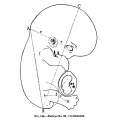Search results
From Embryology
Page title matches
- ...]] Embryo No. {{CE143}}. This embryo 9 mm CRL was probably classified as [[Carnegie stage 15|Stage 15]] occurring during [[Week 5]]. {{Carnegie stage 15 links}}4 members (0 subcategories, 1 file) - 10:19, 22 January 2020
Page text matches
- ...te]][[Category:Carnegie Collection]][[Category:Carnegie Embryo]][[Category:Carnegie Stage 15]][[Category:Week 5]][[Category:1800's]]</noinclude>215 bytes (22 words) - 08:38, 20 October 2020
- ===All Carnegie Embryos listed=== [[Category:Carnegie Embryo 6]]5 KB (496 words) - 11:36, 29 July 2018
- ...age of the human embryo. By George L. Streeter (6 charts, 2 text-figures) 143-170 ..._Embryology_Carnegie_Institution_No.55|'''Carnegie Institution No.55 Human Embryo Size''']]377 bytes (50 words) - 13:29, 30 January 2012

File:Keibel Mall 143.jpg ==Fig. 143 Human Embryo No. {{CE22}}== Embryo No. {{CE22}}(624 × 625 (33 KB)) - 10:35, 27 September 2018- ...rual age of the human embryo''']]. (1920) {{Contrib. Embryol.}} Publ. , : 143-170.<noinclude>[[Category:Template]][[Category:Reference]][[Category:1920's309 bytes (36 words) - 23:40, 6 February 2017
- .... Publ. 274, [[Book - Contributions to Embryology|Contrib. Embryol.]], 11, 143-170.<noinclude>[[Category:Template]][[Category:Reference]][[Category:George307 bytes (37 words) - 18:02, 25 April 2016
- ...5 [[Book - Contributions to Embryology|Contrib. Embryol.]], Publ. 274, 11: 143-170.<noinclude>[[Category:Template]][[Category:Reference]][[Category:George409 bytes (48 words) - 09:54, 22 August 2016

File:Bardeen1906-plate01.jpg ==Plate I. Human Embryo 4 and 4.5 weeks Lower Limb Region== Fig. 1. Embryo {{CE2}}, length 7 mm., age about four weeks.(1,565 × 2,322 (238 KB)) - 23:06, 23 July 2020- | 143 ...ategory:Carnegie Embryo]][[Category:Table]][[Category:Template]][[Category:Carnegie Stage]][[Category:Historic Embryology]]</noinclude>2 KB (128 words) - 17:15, 30 January 2018
- [[File:Carnegie_Institute_of_Washington_logo.jpg|thumb|150px|Carnegie Institute of Washington]] ...n either age or size. The human embryonic period proper is divided into 23 Carnegie stages covering the first 8 weeks post-ovulation.2 KB (272 words) - 08:57, 21 December 2017
- ...n either age or size. The human embryonic period proper is divided into 23 Carnegie stages. Criteria beyond morphological features include age in days, number ...an take from as little as 10 days in chickens to nearly 60 days in humans. Carnegie is the name of a historical US Institute that historically categorised thes5 KB (566 words) - 12:46, 22 May 2018
- ...geal anomalies with visceral and parietal malformations in a human embryo (Carnegie stage 21)=== ...esia and tracheoesophageal fistula) and anomalies at the caudal end of the embryo (anorectal atresia, rectovesical fistula, vertebral and notochordal defects8 KB (1,120 words) - 17:45, 8 March 2016
- Department of EmbryologyThe Carnegie Institution Of Washington, Baltimore, Maryland ...empt was made to recover a specimen comparable to the youngest known human embryo.24 KB (3,966 words) - 16:21, 2 April 2017
- ...as intact, and its development was classified according to the widely used Carnegie stages (CSs). The CS of the specimen was identified as the later half of CS {{Embryo 3.4mm movie 1}}9 KB (1,095 words) - 09:20, 12 May 2020
- ...sion]] and [[Movie_-_Model_Embryo_to_128_Cell_Stage|Flash version]]. Added Carnegie collection [[Carnegie_stage_8#Carnegie_Collection|stage 8 images]]. ...- Model Embryo to 32 Cell Stage|Quicktime version]] and [[Movie - Model Embryo to 32 Cell Stage|Flash version]].26 KB (3,399 words) - 23:53, 20 August 2013
- ...n most convenient, and probably most nearly correct, to rate the age of an embryo and the duration of pregnancy from the last menstrual period. However, from ...e rapid than any of them, and is then overtaken by the {{rabbit}} when the embryo is 5 mm. long, by the {{pig}} at 15 mm., and by the {{dog}} at 20 mm. The d41 KB (6,996 words) - 11:17, 19 August 2020
- [[Carnegie Collection]]: {{CE45}}, {{CE75}}, {{CE86}}, {{CE95}} ...en Kautenhirns''"; a description of these is accordingly unnecessary. Each embryo has been studied in serial sections and from tliese sections a few, at diff17 KB (2,866 words) - 04:19, 19 February 2020
- ...o would correspond to [[Carnegie stage 11]]. Listed as Carnegie Collection Embryo no. 1201a. The embryo is also later described in relation to neural development and shown in Bart19 KB (3,140 words) - 18:43, 23 June 2019
- ...infiltrated decidua. That these chorionic vesicles both once contained an embryo, no embryologist will doubt. It is evident also that both were retained for ...of the thorax. The small nodule, which represents the only remnant of the embryo belonging to the larger chorionic vesicle, contains a large cavity, with th27 KB (4,356 words) - 10:12, 1 December 2012
- ...les R. Essick describes human embryonic {{neural}} development using the [[Carnegie Collection]] embryos. [[Carnegie Embryos]] used in this study: {{CE227}}, {{CE75}} {{CE86}} {{CE145}} {{CE157 KB (9,548 words) - 23:43, 23 July 2020